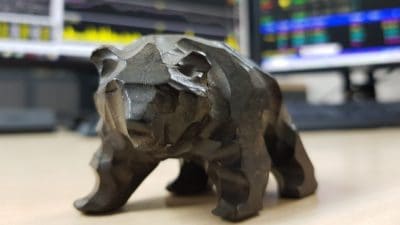How risky are shares? Ask the apocryphal man or woman on the Clapham omnibus, and you’ll probably get the answer ‘very risky’.
Regulatory bodies perpetuate this view, mandating the issuing of various warnings to consumers who considering stock market-based investments in pension and savings products.
And of course, they’re right. Yes, you may not get back the amount that you invested.
But that isn’t to say that you won’t get back the amount that you invested – or, indeed, that cash is better, or safer.
Negative real returns
The problem with cash is simply stated.
Ever since the Bank of England reduced Bank Rate to 0.5% in March 2009, interest-paying cash savings accounts have generally paid less than the rate of inflation.
Meaning that your effective real rate of return – after taking inflation into account, that is – is less than zero.
Put another way, in terms of purchasing power, then it’s been an absolute certainty that savings accounts result in you getting back less than you put in.
But I don’t see the regulators pointing that out. Do you?
Moreover, over the long term, studies such as the prestigious annual Barclays Equity-Gilt series repeatedly show that the stock market does deliver an inflation-beating rate of return.
And, what’s more, one that is higher than that obtained from cash savings, even ignoring the period since March 2009, when rates were slashed following the credit crunch.
9% a year
So, what exactly is this risk that you, me, the financial regulators, and the man and woman on the Clapham omnibus all feel that shares possess?
Well, it’s very real. For one thing, share prices go up, and share prices go down. And if you absolutely have to sell a share, and the price is less than you paid for it, then you’ll get back less than you put in.
But that’s only if you have to sell the shares. If you don’t, then the current share price is largely irrelevant. And – over the long term – shares tend to rise in value.
As I write these words, the FTSE 100 index is at around 7,400. And 30 years ago, it was around 1,700 – a growth rate of just over 5% a year.
And that’s ignoring dividends, of course. On a total return basis, with dividends reinvested, the overall return would have been nearer to 9%.
From market to shares
And yet – to repeat – we all know that shares are risky, and that in theory, if we did have to sell a particular share, the possibility remains that we might be doing so at a loss.
Because while I’m quoting figures showing what the FTSE 100 has achieved, the FTSE 100 index is made up of a hundred individual shares – the market’s largest, and theoretically safest shares, but individual shares nonetheless.
So how do we avoid the risk that our shares might do worse than the market average? (And hopefully, of course, improve the odds that they will do better than the market average.)
Be picky about your picks
In fact, imposing a few straightforward investing disciplines on your share-buying decisions can do a lot to tip the odds in your favour.
Which disciplines? Try these, to start with:
- Spread your risks: hold several shares, rather than one or two. Aim for a portfolio, not a handful of picks.
- Spread your risks (again): diversify. Don’t over-concentrate in a few chosen sectors, no matter how much you think they’ll out-perform. Diversify.
- On the whole, large companies are safer than small ones. All things being equal, the first 50 shares in the FTSE 100 will be more resilient than the second 50 shares.
- Avoid companies with high levels of debt.
- Avoid over-paying: if shares that are too cheap are risky, so too are shares that are too expensive. Look at the share price chart; think about valuation measures such as the price-earnings ratio.
- All things being equal, companies with lots of customers are safer than companies with just a handful of customers.







